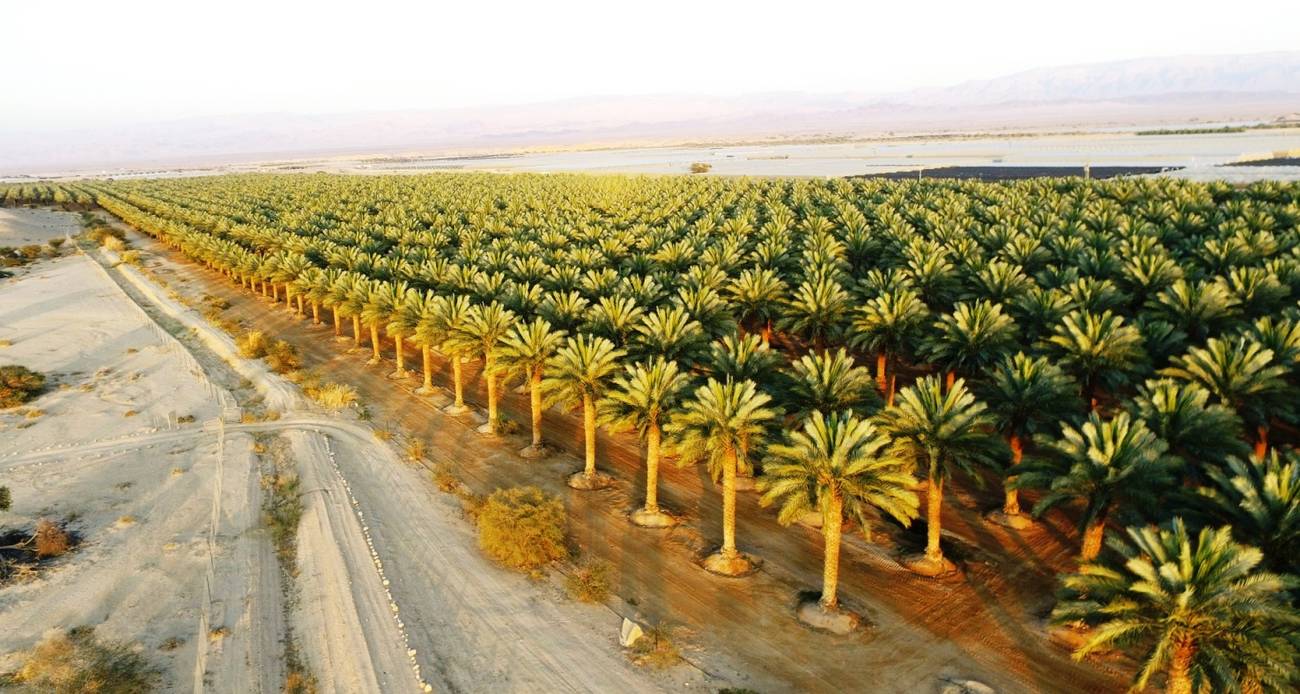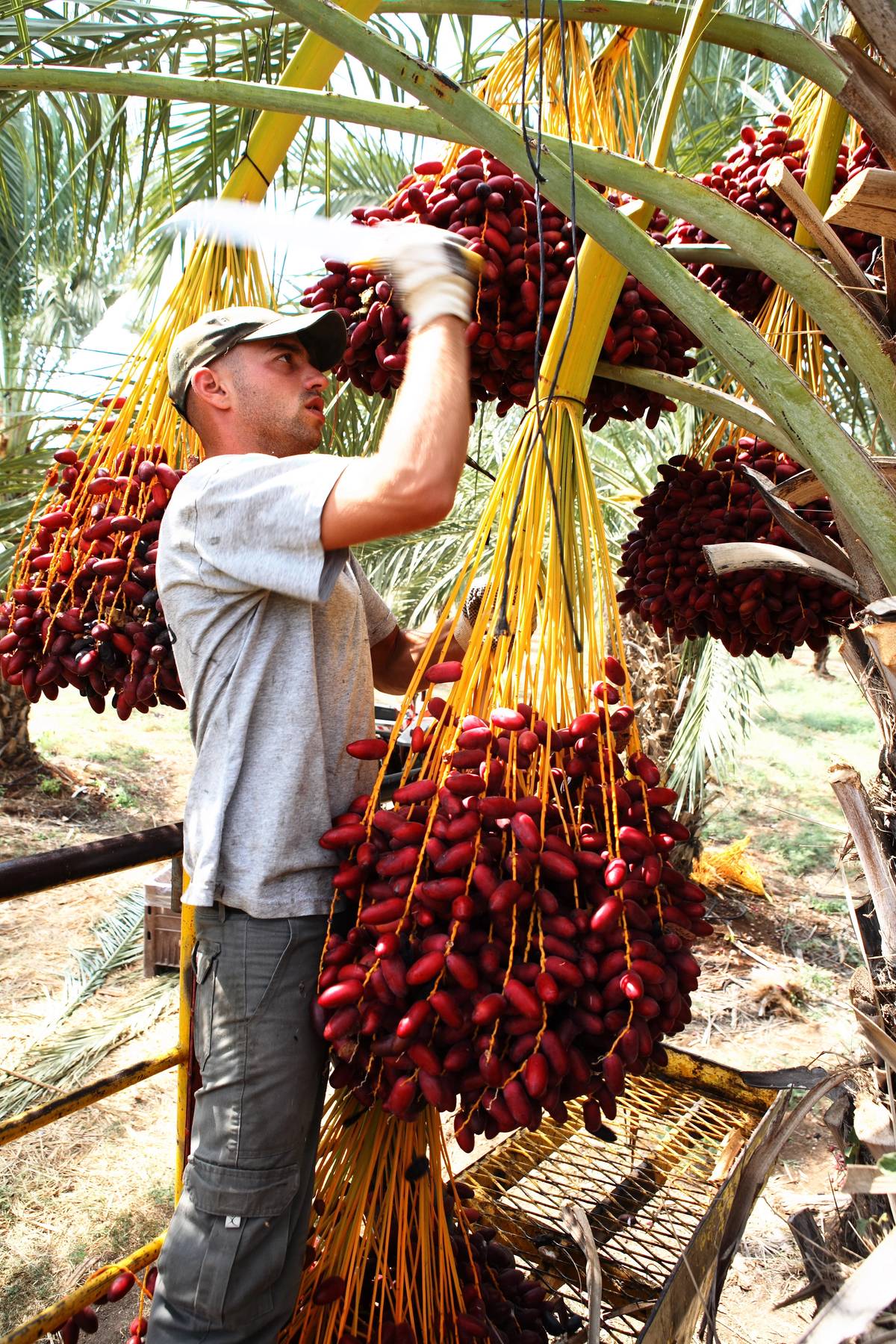Turning Dates Into Honey
How a biblical fruit made a modern-day comeback in Israel



I first came across silan—a thick, chocolatey, not overly sweet syrup made from dates—in the late 1990s in a Tel Aviv health food store. The salesperson raved about the new product: all natural, vegan, and handy for snacking and cooking. “You can use it instead of honey,” she promised. Intrigued, I grabbed a jar, and brought it to our next editorial meeting at Al Hashulchan, the culinary magazine I used to edit, to pitch it for the new products column.
“New product?” cried Ronit, one my colleagues, whose family hails from Iraq. She was almost tearful with emotion: “Every year, before Passover, my dad would go to an old Iraqi lady in Hatikva Quarter and buy her homemade silan, so we can have a proper Iraqi charoset—silan mixed with crushed walnuts.” She went on to tell us that in her dad’s childhood home in Baghdad, handmade silan was a regular fixture. His mother would patiently boil down dates in a huge pot on the roof, then strain and bottle the syrup. In addition to making charoset, silan was mixed with tahini or heavy cream, or slathered on a slice of bread, like jam. “But my dad would drink it on the sly, straight from the bottle.” Ronit sighed: “So many memories, and now you can just go and buy silan in a store.”
The commercial production of silan in Israel indeed started with Iraqi Jews. Employees of Iraqi origin at a fruit packing plant on the shore of the Kinneret (the Sea of Galilee), one of the main date-growing areas in Israel, would often ask permission to take home date scraps destined for dumping. This went on for years, until one day the plant manager got curious and asked what they did with the scraps. The following day he got his first taste of homemade silan and decided to develop it for commercial production.
About a decade ago, Al Hashulchan published an extensive survey about the eating, cooking, and shopping habits of Israeli foodies. One of the questions read simply: silan or honey? The results split almost evenly between the two. This may have been surprising to some, since silan was largely unknown just a couple decades earlier. But it had become very popular very quickly. A jar of silan now graces the shelves of most Israeli kitchens, domestic and professional alike, right next to olive oil and tahini. We drizzle it on yogurt, ice cream, and oatmeal. We whisk it with olive oil and lemon juice to make vinaigrettes, or with garlic and soy sauce to whip up a flavorful marinade for meat or poultry. We even add it to cake or cookie batters or swirl it with tahini to make a sandwich spread (some call it Israeli peanut butter and jelly).
Ostensibly, silan belongs to a paradigm of Jewish immigrant foodstuffs (think Yemenite z’hug, Moroccan preserved lemons, or Iraqi amba) that made it to the mainstream Israeli pantry, but there is a twist in the plot. The introduction of silan to the Israeli food scene was in fact a reintroduction of a very ancient local product. Date syrup was very common in the biblical food culture. Along with grape syrup, it was used to sweeten food and wine. Both were referred to as dvash—Hebrew for honey. Most biblical scholars are convinced that the honey in the famous expression “Land of Milk and Honey” is actually date honey. However, while grape syrup, called dibbes (honey in Arabic) remained part of the local gastronomy, date syrup disappeared from the region and only returned to Israel in the late 20th century.
On the lakeshore stands a date palm, droopy-topped,
Like a naughty tot with windblown locks
Who has slid down the slope, dabbling his feet
There in the water of the Sea of Galilee.
(translated from Hebrew by Vivian Eden)
This stanza is from the famous poem “Kinneret” written by Rachel Bluwstein (better known as Rachel the Poetess) and published in 1927. Apparently, she refers to a specific tree, a landmark, almost a rarity. Indeed, when Jewish settlers arrived in Palestine in the early 20th century, they found very few palm trees.
In biblical times, date palms grew abundantly along the Jordan River valley, between Jericho and the Dead Sea, enjoying the combination of very hot, dry weather and proximity of water (palm trees need a lot of irrigation). Judean dates were considered a delicacy and were highly prized across the Roman Empire. In the first century CE, following the destruction of the Second Temple, a series of commemorative Roman coins were minted to celebrate the victory. The most famous category was called “Captive Judea,” featuring a triumphant Roman soldier standing next to a palm tree (a symbol of Judea) and a humbled kneeling female figure.

In the Middle Ages, starting with the Mamluk period, cultivation of palm trees in the region gradually deteriorated. By the beginning of the 20th century, there were about 60 acres of date palms cultivated in the Gaza area and occasional trees in other parts of Palestine, like the one that caught the eye of Rachel the Poetess.
From an economic standpoint, renewing the date palm-growing tradition didn’t make much sense. Local markets were brimming with inexpensive dates imported from Egypt, Iraq, and Iran. Plus, early settlers, recently turned farmers, lacked the expertise required to cultivate this extremely labor-intensive crop. What they had in spades was passion, a Zionist dream if you will, to return one of the symbols of the biblical Land of Israel to its former glory. It wasn’t an easy task—date-growing countries, like Egypt or Iraq, forbade importing palm tree saplings, so they had to be smuggled.
The person most associated with the clandestine palm tree operations was Benzion Israeli from kibbutz Kinneret, later joined by Yacov (Yani) Avidov of Nahalal. Over more than two decades, they brought in thousands of palm saplings from across the Middle East. In 1953, the minister of the Treasury of the recently founded State of Israel, assigned Avidov and Israeli their biggest mission yet: delivery of 30,000 saplings from Iran. The two got as far as Pakistan, but had to retrace their steps because of the extreme heat. A year later Benzion Israeli was killed in an air crash and Avidov completed the mission on his own.
The operation was not supposed to be clandestine, as the Iranian shah, who was on friendly terms with the Israeli government, sanctioned the purchase. Still, the plan was conducted in complete secrecy. Avidov was worried that Arab countries would get wind of the deal, and convince the shah to retract his consent, or that Egyptian authorities would block the ship’s passage through the Suez Canal. Avidov chartered an Italian ship in the Iranian port of Mashar and ordered the captain to sail her to Europe. Only a few days into the trip, when the ship was already on its way to Suez, Avidov disclosed the real destination. The captain was livid but at that point had little choice but to deliver the ship and cargo to the Haifa port. The saplings that survived the journey were planted in the Arava desert, laying foundations for what would evolve as the prime date-growing region in Israel.
Today Israel is a major player in the global date market with almost 17,000 acres of date palms, planted along the Syrian-African Rift, from the Kinneret in the north to Eilat in the south. The annual yield is about 50,000 tons, half of it exported. There are nine varieties cultivated in Israel, but the vast majority are large, lush, juicy medjools.
“Do you know the meaning of the word medjool?” asked Danny of Pitzuchey Meir (the best place in Jaffa for dried fruit and roasted nuts) a few years ago, as he was handing me a bag of luscious honeyed beauties. “It means ‘unknown’ in Arabic. And do you know why? During one of the smuggling operations, as the trees were loaded on a truck in the middle of the night, one of the Israelis asked which variety they were loading. ‘Unknown’ was the answer he got, and the name stuck.” This sounded like a cool story, and as I was already familiar with the date smuggling saga, it rang true. So I did some basic fact checking, and learned, that a) it was a complete fiction, and b) the real story was much cooler.
The story of medjool palms starts in Morocco, where they were discovered accidentally in an obscure oasis in the heart of Sahara Desert—hence their name. So succulent and delicious were the dates from the secret oasis that they were, quite literally, deemed fit for a king and planted exclusively in the royal garden in Rabat, the capital of Morocco. About a hundred years ago, the medjool palms contracted a disease and started to die. Since the royal garden was the only known location where medjool palms grew, the prized variety faced extinction. Enter Dr. Walter Swingle, a renowned American botanist, summoned by the French authorities (Morocco was still a French colony in those days) to rescue the priceless palms. He picked a dozen saplings from the least affected trees, and took them to the U.S., where after an extensive quarantine and treatment he successfully planted them first in the Nevada desert and then in the Bard Valley, California, where they thrive to this day. Today, medjool palms grow across the world, from Australia to the Middle East, and all of them are children of the sickly Moroccan saplings revived by an American botanist. Half of all the medjools sold around the world today come from Israel.
In the last decades, all the new palm tree plantings in Israel are exclusively medjool and the very best ones come from the Arava desert. The same combination of extreme arid heat and a cocktail of brackish water drawn from artesian wells that is responsible for candy-sweet cherry tomatoes and extra juicy bell peppers also yields medjools of unparalleled beauty.
Such is the popularity of medjools today that they have eclipsed other date varieties. I recall a date vendor at the Tel Aviv farmers market calling them “beginner dates.” “Sure, medjools are large, super juicy and very sweet,” he argued, “but their flavor is one-dimensional.” The latest trend among knowledgeable foodies is to explore other date varieties, like golden toffee flavored zahidi, honeyed smooth skinned deglet noor, meaty chocolatey deri, or crunchy bar’hi, aka the yellow date, which is the first one to be harvested and it stays on the market for only two months around Rosh Hashana.
The renewed interest in less pervasive date varieties is spurred by a minitrend of varietal silan. Recently, in a Tel Aviv home of a fellow food writer, Adeena Sussman, I tasted side-by-side two organic silans produced according to traditional methods in kibbutz Samar, near Eilat. One was made from deglet noor (that used to be the most common date variety before the ascension of medjool), the other from medjool. Both silans were delicious, but the deglet noor was considerably better—less sweet, with more complex fruitiness, an unexpected hint of tartness and luxuriously thick, jammy texture.
If you travel around Israel right now, especially in the Arava desert or the Kinneret, you might still witness date-picking, called gadid in Hebrew. It is an impressive sight: pickers climbing to treetops on specially designed cranes, and hacking off majestic fruit-laden branches with machetes. Gadid starts in late summer and continues well into October. Freshly picked dates will reach markets in Israel and around the world, and some of them will be transformed into silan, the ancient biblical honey that has been given a new lease on life and culinary sophistication.
Janna Gur is a Tel Aviv-based writer and journalist. She is the author of The Book of New Israeli Food, Jewish Soul Food from Minsk and Marrakesh, and Shuk (with Einat Admony).